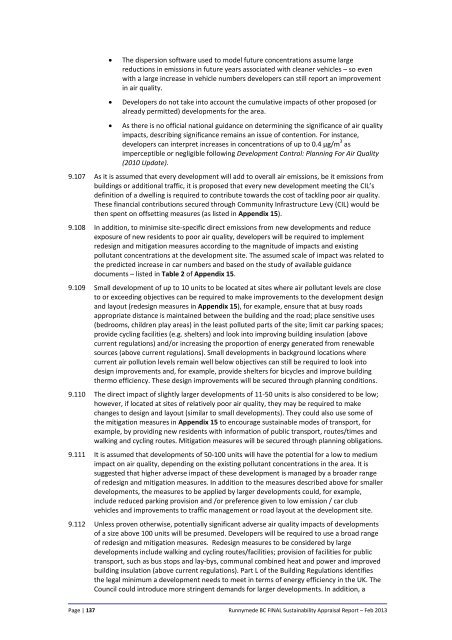DRAFT Sustainability Appraisal Report for the Emerging Local Plan ...
DRAFT Sustainability Appraisal Report for the Emerging Local Plan ...
DRAFT Sustainability Appraisal Report for the Emerging Local Plan ...
Create successful ePaper yourself
Turn your PDF publications into a flip-book with our unique Google optimized e-Paper software.
The dispersion software used to model future concentrations assume large<br />
reductions in emissions in future years associated with cleaner vehicles – so even<br />
with a large increase in vehicle numbers developers can still report an improvement<br />
in air quality.<br />
Developers do not take into account <strong>the</strong> cumulative impacts of o<strong>the</strong>r proposed (or<br />
already permitted) developments <strong>for</strong> <strong>the</strong> area.<br />
As <strong>the</strong>re is no official national guidance on determining <strong>the</strong> significance of air quality<br />
impacts, describing significance remains an issue of contention. For instance,<br />
developers can interpret increases in concentrations of up to 0.4 µg/m 3 as<br />
imperceptible or negligible following Development Control: <strong>Plan</strong>ning For Air Quality<br />
(2010 Update).<br />
9.107 As it is assumed that every development will add to overall air emissions, be it emissions from<br />
buildings or additional traffic, it is proposed that every new development meeting <strong>the</strong> CIL’s<br />
definition of a dwelling is required to contribute towards <strong>the</strong> cost of tackling poor air quality.<br />
These financial contributions secured through Community Infrastructure Levy (CIL) would be<br />
<strong>the</strong>n spent on offsetting measures (as listed in Appendix 15).<br />
9.108 In addition, to minimise site‐specific direct emissions from new developments and reduce<br />
exposure of new residents to poor air quality, developers will be required to implement<br />
redesign and mitigation measures according to <strong>the</strong> magnitude of impacts and existing<br />
pollutant concentrations at <strong>the</strong> development site. The assumed scale of impact was related to<br />
<strong>the</strong> predicted increase in car numbers and based on <strong>the</strong> study of available guidance<br />
documents – listed in Table 2 of Appendix 15.<br />
9.109 Small development of up to 10 units to be located at sites where air pollutant levels are close<br />
to or exceeding objectives can be required to make improvements to <strong>the</strong> development design<br />
and layout (redesign measures in Appendix 15), <strong>for</strong> example, ensure that at busy roads<br />
appropriate distance is maintained between <strong>the</strong> building and <strong>the</strong> road; place sensitive uses<br />
(bedrooms, children play areas) in <strong>the</strong> least polluted parts of <strong>the</strong> site; limit car parking spaces;<br />
provide cycling facilities (e.g. shelters) and look into improving building insulation (above<br />
current regulations) and/or increasing <strong>the</strong> proportion of energy generated from renewable<br />
sources (above current regulations). Small developments in background locations where<br />
current air pollution levels remain well below objectives can still be required to look into<br />
design improvements and, <strong>for</strong> example, provide shelters <strong>for</strong> bicycles and improve building<br />
<strong>the</strong>rmo efficiency. These design improvements will be secured through planning conditions.<br />
9.110 The direct impact of slightly larger developments of 11‐50 units is also considered to be low;<br />
however, if located at sites of relatively poor air quality, <strong>the</strong>y may be required to make<br />
changes to design and layout (similar to small developments). They could also use some of<br />
<strong>the</strong> mitigation measures in Appendix 15 to encourage sustainable modes of transport, <strong>for</strong><br />
example, by providing new residents with in<strong>for</strong>mation of public transport, routes/times and<br />
walking and cycling routes. Mitigation measures will be secured through planning obligations.<br />
9.111 It is assumed that developments of 50‐100 units will have <strong>the</strong> potential <strong>for</strong> a low to medium<br />
impact on air quality, depending on <strong>the</strong> existing pollutant concentrations in <strong>the</strong> area. It is<br />
suggested that higher adverse impact of <strong>the</strong>se development is managed by a broader range<br />
of redesign and mitigation measures. In addition to <strong>the</strong> measures described above <strong>for</strong> smaller<br />
developments, <strong>the</strong> measures to be applied by larger developments could, <strong>for</strong> example,<br />
include reduced parking provision and /or preference given to low emission / car club<br />
vehicles and improvements to traffic management or road layout at <strong>the</strong> development site.<br />
9.112 Unless proven o<strong>the</strong>rwise, potentially significant adverse air quality impacts of developments<br />
of a size above 100 units will be presumed. Developers will be required to use a broad range<br />
of redesign and mitigation measures. Redesign measures to be considered by large<br />
developments include walking and cycling routes/facilities; provision of facilities <strong>for</strong> public<br />
transport, such as bus stops and lay‐bys, communal combined heat and power and improved<br />
building insulation (above current regulations). Part L of <strong>the</strong> Building Regulations identifies<br />
<strong>the</strong> legal minimum a development needs to meet in terms of energy efficiency in <strong>the</strong> UK. The<br />
Council could introduce more stringent demands <strong>for</strong> larger developments. In addition, a<br />
Page | 137 Runnymede BC FINAL <strong>Sustainability</strong> <strong>Appraisal</strong> <strong>Report</strong> – Feb 2013

















